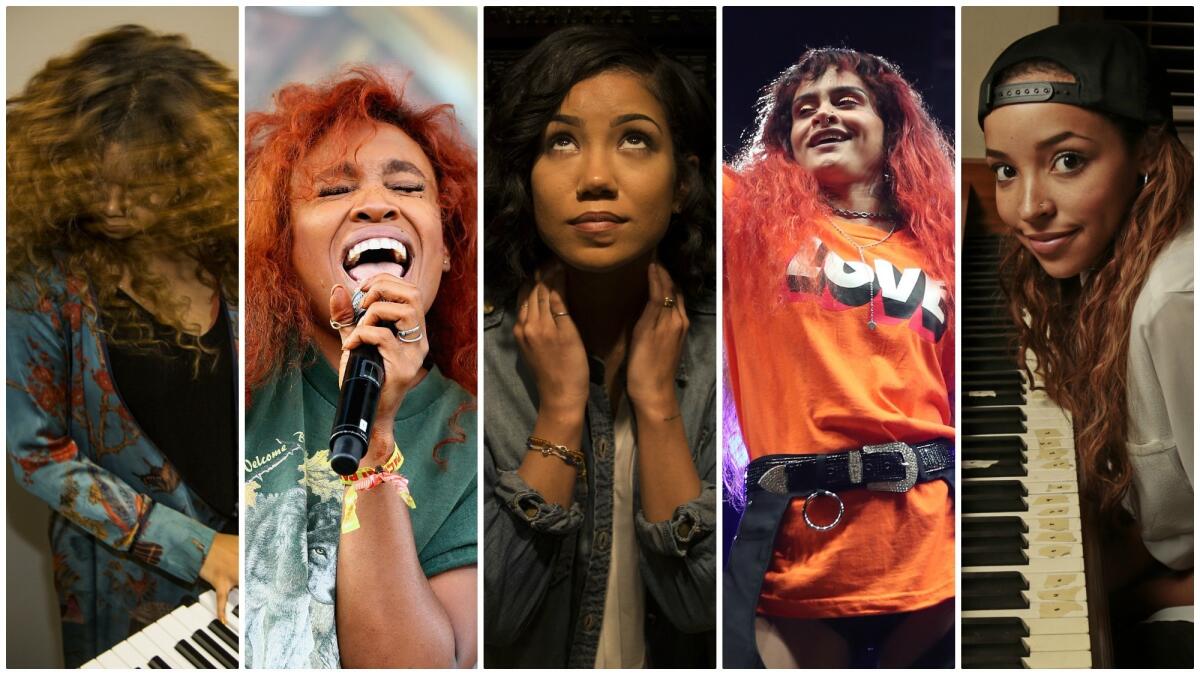‘When you’re black you have to fight’: Tinashe, Kehlani and other female R&B artists struggle for attention

Three years ago, all the signs pointed one way: Tinashe was on her way to pop stardom.
In 2012, when she was just 19, she produced two critically acclaimed mixtapes that landed her a deal at RCA. A year later her debut single, “2 On,” made it to No. 24 on Billboard’s Hot 100. Her 2014 debut album, “Aquarius,” was met with critical acclaim and she was nominated for a BET Award.
Since then, the singer-songwriter has toured with Nicki Minaj and Katy Perry, collaborated with Britney Spears, earned praise from idol Janet Jackson and issued two buzzy projects, including last year’s digital-only work “Nightride.”
Yet Tinashe’s career has hit an impasse.
Nearly two years after it was announced to much hype, RCA has yet to release her long-gestating sophomore album, “Joyride.” As a string of genre-hopping singles and collaborations with artists like Spears, Chris Brown and Young Thug failed to produce a major hit, “Joyride” and her young career have stalled.

Attempting a restart, she has learned many things: that pop hits speak louder than reviews, only crossover stars make real money and being a black female performer comes with inherent challenges.
“Critical acclaim hasn’t been enough in my experience,” said the 24-year-old, who was born Tinashe Kachingwe. “The label appreciates it, but the music business, in my perspective, is still so much based on revenue and how much they are making in sales. That’s where it gets really [crappy].”
“You just want to make art for the sake of art,” she continued, “and not have people [care] about a number, first-week sales or things like that.”
It’s a feeling shared by artists everywhere, and success rarely comes easily in the music industry. But Tinashe’s experiences also speak to the real and quantifiable difficulty of being a black woman in the pop landscape.
“When it comes to black women, people want to put you in these almost race-driven musical genres,” she says. “[Our] songs automatically become ‘urban’ or ‘rhythmic.’ I was creating music that didn’t necessarily fall into what people [considered] black female music — and there was pushback.”
Though a new generation of women of color —Tinashe, Kehlani, Sevyn Streeter, Jhene Aiko, H.E.R. and SZA, among others — are making waves with wildly different takes on R&B, and producing some of the genre’s most exciting work, they often find themselves departmentalized into racialized genres.
And without a song that crosses over onto pop radio, they risk being ignored.
“It’s hard for a woman to do anything, but when you’re black you have to fight,” says veteran superstar Mary J. Blige, who faced insecurities even 25 years into a storied career.
“I fought, although I was hearing it was over [for me],” she continued. “But I kept going because I felt in my spirit there’s more I have to do.”
“With a female singer of color, there’s so much pressure on us,” agrees singer-songwriter Kehlani.

In Nielsen Music’s recently released mid-year report, R&B/hip-hop proved to be the most consumed genre — after combining album sales and on-demand streaming figures — for the first time in history. The total volume of R&B/hip-hop consumption was nearly as much as the totals of rock (which leads in pure album sales) and pop combined.
But black female artists are rarely part of that dominance, especially as male-driven hip-hop continues to soar.
In the past 10 years, Rihanna, Beyoncé and Mariah Carey were the only black women to land a No. 1 single on the Billboard Hot 100 and top album charts as a lead artist.
In contrast, more than a dozen white female artists have sat atop the charts, and that sum more than doubles when considering male artists of any race making R&B and hip-hop music.
“For some reason, people are consuming male-based entertainment on a much greater scale,” Tinashe said. “You look at the pop charts and there are no black women. And it looks like that on rhythmic and urban charts. Perhaps it’s a subject matter issue? Maybe it’s the gatekeepers? I can’t put my finger on it.”
Earlier this year Kehlani’s major-label debut, “SweetSexySavage” hit No. 1 on the R&B chart, making her the first of three women to top the R&B album chart this year (Blige and SZA are the others).
Kehlani’s acclaimed mixtapes — 2015’s “You Should Be Here” earned a Grammy nod — and the tens of millions of Soundcloud streams she logged made her R&B’s next “It girl,” but she grew frustrated that she was only ever compared to other black female artists, regardless of style.
And, more important, that there seemed to be room for only one of them at the top.
“No one ever says, ‘Oh, she’s trying to be the next Britney or the next Christina.’ Yet somehow me, Tinashe, Jhene all wanna be Aaliyah,” she said. “People try to pit us against each other … but I don’t want to be put in a box or given these weird expectations or limitations.”
“It creates this competitiveness, even among fan bases,” Tinashe added. “People feel they can’t be a fan of Kehlani and me. It’s confusing, like why not be fans of whatever you like? Why does there need to be this rivalry approach? We don’t do that with male artists.”
Such comparisons persist, even as the women are pushing the boundaries of the genre. The end result, artists said, is a fear of experimentation.
Like many young acts, Tinashe blurs genre lines. After her teen-pop girl group fizzled, she began recording herself in her bedroom studio from which she issued her first mixtape in 2012. Tinashe’s releases are kaleidoscopes of alternative R&B and dreamy pop. Her breakout single was bouncy electro-R&B, she’s recorded EDM, garage and Latin pop collaborations, and the first two singles from “Joyride” were sugary synth-pop confections.
But genre-hopping, she believes, isn’t as accepted when it comes to black women.
“People are so stuck in these genre barriers. It’s shocking that it’s still such a … thing,” she said.
In a recent interview about her career frustrations with a British newspaper, Tinashe pointed to industry sexism and genre limitations as barriers that sideline women of color. But it was the generalized statement she made on colorism — a subject that’s been contentiously debated for a century — that got the most attention.
“Sometimes I feel like I don’t fully fit into the black community; they don’t fully accept me, even though I see myself as a black woman,” she told the British paper. “That disconnect is confusing sometimes.”
She now says her words were taken out of context — she was making a point about growing up mixed race — but many felt she was blaming black consumers for her career problems, and in fact exacerbating the divisions between light- and dark-skinned women.
Which, many in the industry agree, is a real issue and a force keeping black women off the charts.
“I’ve seen dark-skinned women sing the roof off and get no attention from labels because of their complexion and it’s sad,” said artist manager and Grammy-winning executive producer Jeff Robinson. “It’s unfortunate that they are not given the same opportunities.”
Representatives from Tinashe’s label, RCA, didn’t respond to a request for comment.
Sevyn Streeter felt it early in her career as she navigated two short-lived R&B girl groups.

“In my first group, I had records I would sing that, when we shot the videos, somebody else would lip sync. In my second group … I still dealt with the same things — not being able to sing certain leads or pushed out front because of my complexion. Because I was, undeniably, a black woman,” Streeter recalled.
“People would try to paint it another way and pretty it up, but I knew what it was,” she continued. “Once I was on my own and it wasn’t me, this black girl, surrounded by other women of different ethnicities and complexions I was still very conscious of whether or not people would accept me being this brown-skinned black woman.”
Those experiences left Streeter anxious and the discouragement continued as she struggled to get her debut off the ground.
Though she had already scored a Grammy for her songwriting for Chris Brown, she spent five years trying to get her album out, constantly having to pivot when singles didn’t cross over. “Girl Disrupted” (its title a nod to her career strife) finally arrived in July.
“I was going through the craziest bout of depression,” she admitted. “My fans were like, ‘Where is the album? Where is the music?’ — and I was having thoughts of taking my own life.”
Because they are expected to be glamorous at all times, female artists are generally more expensive to promote than male acts and black women, Streeter says, are often low priority when it comes to label marketing funds.
“[Labels think] particular genres of music make more money and sponsors buy into that because of what history has shown us over the years,” she said. “Because of the amount of acceptance white artists get, they tend to get a lot more … but when it comes to urban acts, especially female ones, it’s harder to sell people.”
A veteran label executive disagreed with the notion that women of color are worked less aggressively, but admitted deep-rooted prejudice makes it harder.
“Black women, sadly, don’t represent the standard of beauty in America. Neither do Asian or Hispanic women — but nor do white, brunet women. A great number of black women have shown the beauty of diversity and broken through but it really, always, comes down to the song,” said the executive, who requested anonymity because of the nature of her work and the sensitivity of the subject.
“I do sympathize with the feelings of new black artists,” she continued. “R&B is a challenge, but it’s about figuring out where you fit in the landscape and knowing who you are as an artist.”
Solutions vary depending on who’s asked, but everyone interviewed for this piece says change will start with increased representation behind the scenes.
While Streeter and Tinashe have written for high-profile acts like Ariana Grande and Fifth Harmony, respectively, there’s a massive dearth of women of color behind the boards or in high-ranking positions within labels, publishing, management, publicity, touring and branding.
“The music industry is a difficult environment for black women to survive in,” said producer Harmony Samuels. “Whether it’s on the business, corporate side or as an artist — it’s hard, but it’s harder for black women in general, in any industry.”
Kehlani thinks more collaborations among women will cut down the idea that they can’t all coexist, something Robinson would like to see on a touring level, pointing to the star-studded Ladies First tour he curated in 2004 featuring Beyoncé, Alicia Keys and Missy Elliott.
Tinashe remains hopeful. She built a studio inside her new home and is continuing work on her album. “At this point I need to get back to what’s important to me, which is making art,” she said. “These setbacks or adversity, I take it as a learning experience.”
Ultimately, Tinashe said, listeners need to accept that black women come in all shades — and sounds.
“People want to automatically assume that black women just want to be an ‘R&B girl’ but we all have pop appeal and defy general stereotypes of genre,” she said. “People need to expand their mind-sets.”
ALSO:
With ‘Girl Disrupted,’ Sevyn Streeter’s been waiting 15 years for this moment
The enigmatic R&B singer H.E.R. gives first face-to-face interview without confirming identity
More to Read
The biggest entertainment stories
Get our big stories about Hollywood, film, television, music, arts, culture and more right in your inbox as soon as they publish.
You may occasionally receive promotional content from the Los Angeles Times.











